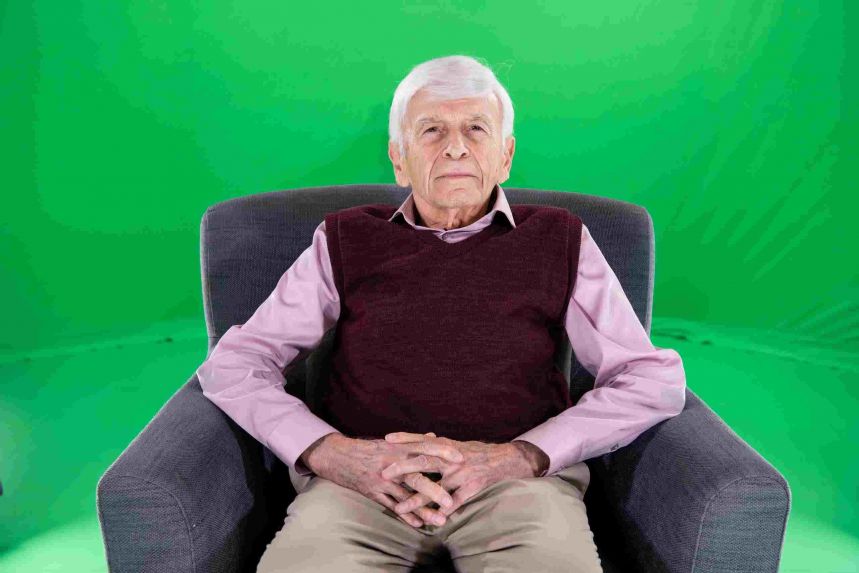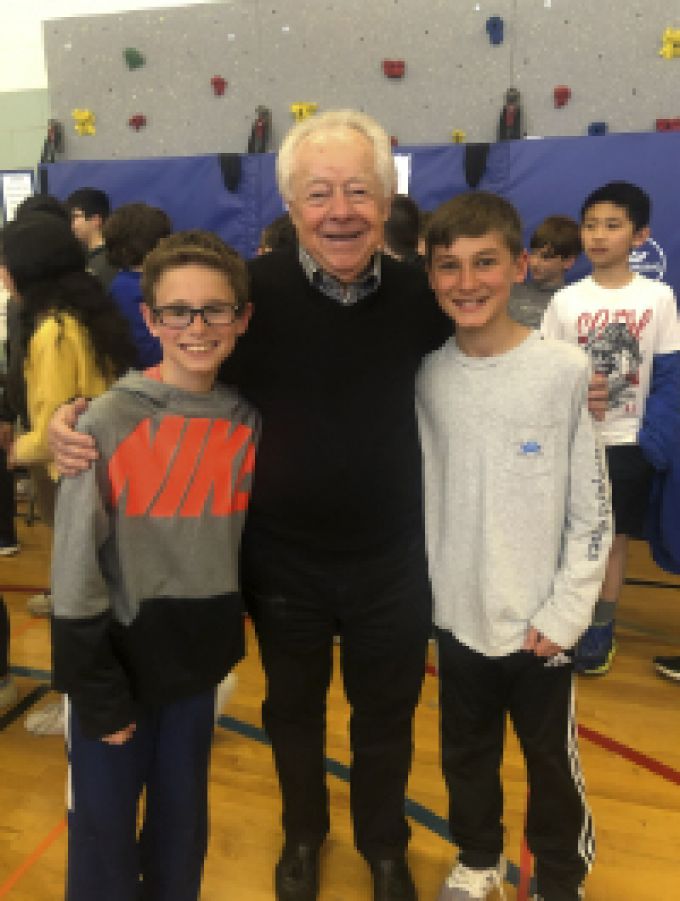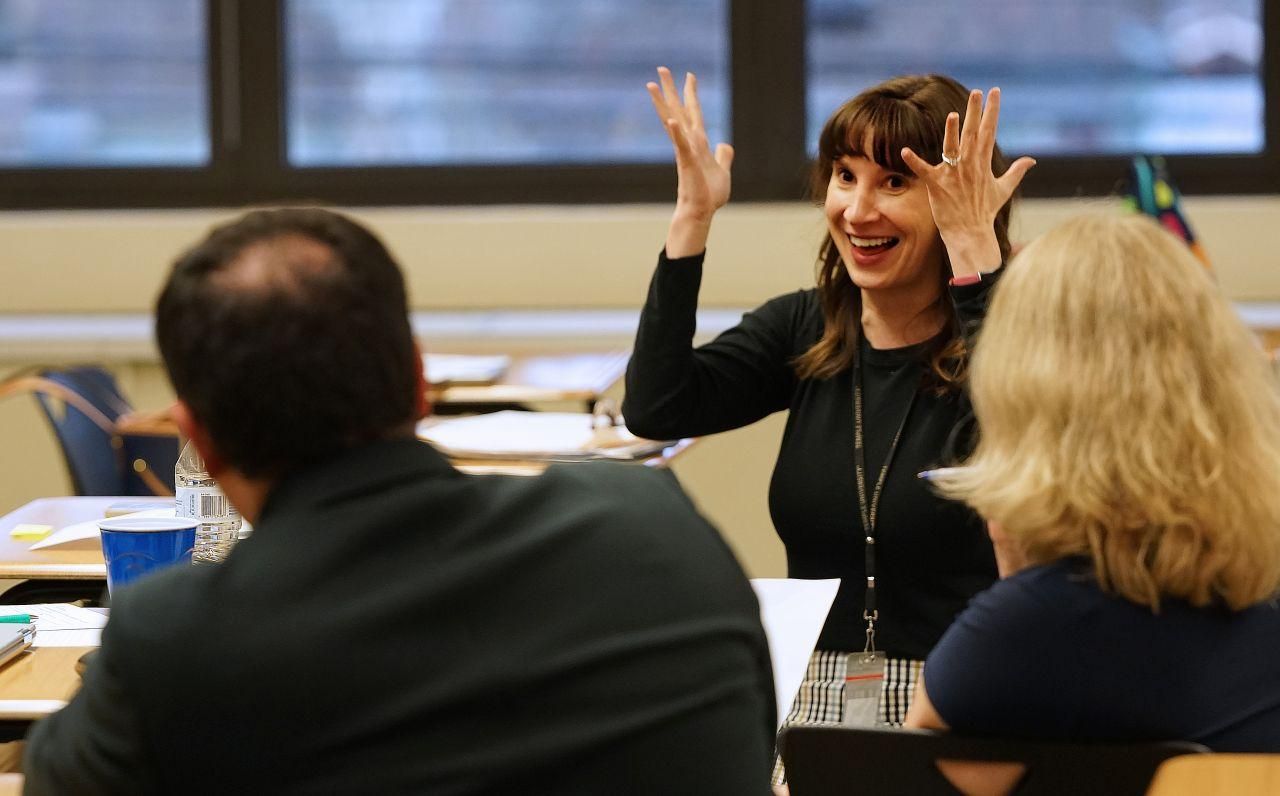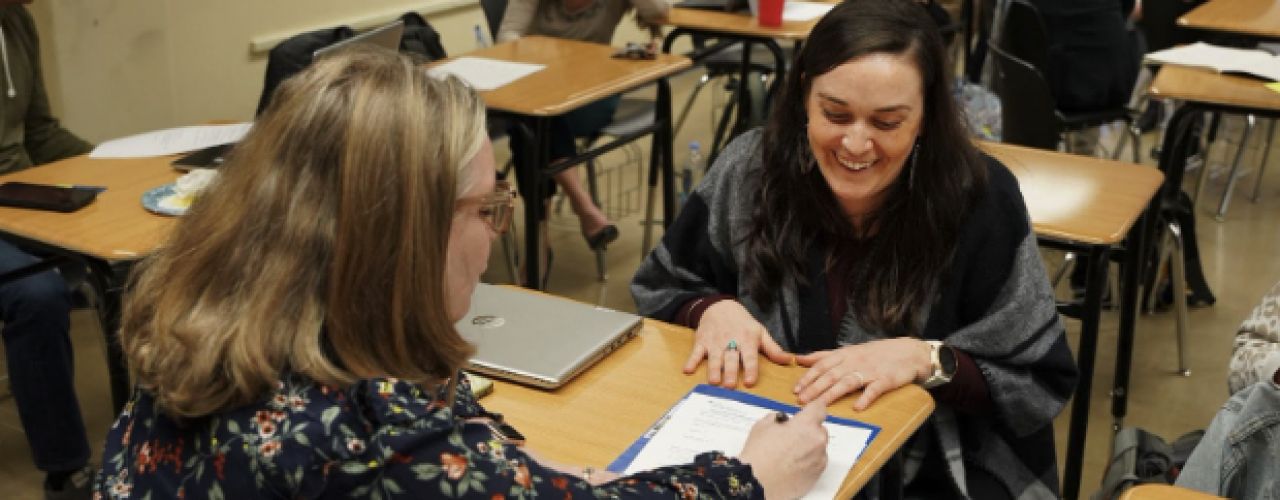October 30, 2023
Holocaust survivors' legacy living out through innovative education

Holocaust survivor Max Eisen during filming of Dimensions in Testimony from the Shoah Foundation.
Credit: The Shoah FoundationMax Eisen is silver-haired and composed, seated in a large gray armchair and dressed in a burgundy sweater vest over a pink button-down shirt. He speaks slowly and somberly, his mind spinning back more than seven decades to the moment he first saw the world’s most infamous death camp.
“I could see the entire layout of Auschwitz to Birkenau, hundreds of wooden barracks. And there were four huge buildings with very big chimneys. Fire and flames and smoke was coming out, and I thought it was a huge industrial zone,” he says. “Well, it actually was an industrial place of killing people in an industrial manner.”
He would spend eight months there. He would watch as his own father was led to the gas chambers. “Never forget you are a Jew," Zoltan Eisen told his teenage son at that moment, handing him a small prayer book he had hidden.
And this: “He told me that ‘If you manage to survive, you need to tell the world what happened here.’”
Eisen took those words to heart, and he continues to preserve the memory of his loved ones and share his stories of the Holocaust — though he died at 93 in July 2022.

A screenshot of Max Eisen's conversational artificial intelligence from the Dimensions in Testimony website.
You can talk to him today because of the Shoah Foundation’s Dimensions in Testimony project at the University of Southern California, where conversational artificial intelligence allows users to witness interviews with Holocaust survivors — and to conduct the interviews themselves.
The Challenge
As the number of Holocaust survivors dwindles and incidents of antisemitism have risen in recent years across the United States, the importance of remembering the Jewish journey has taken on a new urgency. Experts in history, film and education are helping to tell a story 90 years after Adolf Hitler came to power in Germany. Now and in the future, innovative methods will teach about the Holocaust, even without survivors corporeally present.
There are high-tech recordings of the stories of people who lived through those dark days, like Eisen. There are the efforts of their own survivors, in concert with the survivors of Germans who were complicit in the Nazis’ actions. And there is the work of educators to develop new ways to incorporate the lessons of the Holocaust in schools.
“There’s a universal message there to be remembered, and these individual stories cannot be forgotten,” said Kia Hays, who worked with Eisen on his Dimensions in Testimony.
In 2010, the Conference on Jewish Material Claims Against Germany estimated there were 127,300 living Holocaust survivors in the United States. It estimated there would be 67,100 in 2020, and that number would decrease to 36,800 by 2025. By the end of the decade, there would be just 15,800.
36%
The Anti-Defamation League found a 36% increase in antisemitic incidents in the United States from 2021 to 2022.
Against that backdrop, the Anti-Defamation League found a 36% increase in antisemitic incidents in the United States from 2021 to 2022, and the highest number of reported incidents — 3,697 — on record since the start of their tracking in 1979. It also noted a 49% increase in antisemitic incidents at non-Jewish K-12 schools and a 41% increase on college campuses.
Findings from a league study “strongly indicate that Holocaust education can be an effective intervention against antisemitic beliefs.” The same study said, “Individuals who have had education on the topic of the Holocaust also show higher rates of critical thinking and a greater willingness to challenge intolerant behavior. Collectively, this helps to build a better society.”
In 1994, acclaimed film director Steven Spielberg founded the Shoah Foundation to videotape and preserve interviews with survivors and other witnesses of the Holocaust. The foundation, now at the University of Southern California, says it maintains more than 56,000 audio-visual testimonies logging over 115,000 hours conducted in 65 countries and in 44 languages.
And the foundation collaborated with StoryFile, a private company that creates conversational video artificial intelligence. Its “storyfiles” of Holocaust survivors allow people to ask these elders questions even after their deaths.
“It’s easy, especially the further we get away from events, to think of them in a geopolitical, abstract way of dates and numbers, to forget the individual impact,” said Hays, senior vice president of professional services at StoryFile. “Understanding some of those who were most drastically impacted (by World War II) and the way it changed their entire trajectory is really important.”
StoryFile’s creators write a script of questions based on the project’s goals and conduct interviews with subjects over several days.
A collaboration between Meta and StoryFile yielded “Tell Me, Inge …,” an animated, interactive conversation with survivor Inge Auerbacher in virtual reality. Auerbacher sits surrounded by significant objects and phrases from her story which prompt questions from the viewer, which she then answers.
Hays described Auerbacher as the “director” of her project. “The agency of the person telling the story is super important,” she said. “It’s (Inge’s) story told in her way, and we have to adapt to it.”
Mark Schonwetter, a survivor who regularly educates about his experience through in-person appearances, recently filmed his own storyfile.
“You can share your survival in the future without being here anymore,” said Schonwetter, who now lives in New Jersey. The people he hopes to reach “will try to learn from what happened in the past so that nothing like it will happen in the future.”
Schonwetter feels that Holocaust education has been ineffective. Often asked to meet with students who had committed antisemitic acts, he recalled how in one case, kids drew a picture of a swastika, the Nazi symbol. In conversation, he learned that they only knew the swastika was the symbol of Hitler, who was just a “leader of the German people.”
“I found that those kids didn’t have the slightest idea that what they did was antisemitism,” he said.
A survey conducted by the Claims Conference in 2020 found that 48% of U.S. millennials and Gen Z could not name one of more than 40,000 World War II concentration camps or ghettos. The survey also yielded that 56% of U.S. millennials and Gen Z could not identify Auschwitz-Birkenau, where about a million Jews died of the 6 million killed in the Holocaust.


Never Again
In her 1985 testimony for Yale University, a survivor, Helen Kopman, expressed concern that the world was not learning from the Holocaust’s horrors.

A screenshot of Helen Kopman's 1985 testimony recorded by Yale University, from YouTube.
“When I was in the concentration camp and even after, I said to myself, ‘You know, after the war, people will learn. They will know. They will see, and they will learn,’” Kopman said. “But did they really learn anything? I don’t know.”
In the early 2000s, around the Jewish high holidays, Kopman and her daughter, Judy Kopman-Fried, visited family graves in New Haven, Connecticut. They found their family’s tombstones overturned and desecrated.
“I remember feeling so angry and so upset for her that in her lifetime she would have to see that,” Kopman-Fried said.
Kopman died in March 2004 of chronic obstructive pulmonary disease. Kopman-Fried said the tuberculosis she contracted at Auschwitz and Nazis’ refusal to treat her led to her death.
Kopman-Fried received a small settlement from the German government and founded the Helen Kopman Holocaust Education Fund to help teachers make students in public schools aware of the Holocaust.
Through her educational work, Kopman-Fried met Claudia Kiesinger, a granddaughter of two Nazi party members. Now, they use their stories to educate together.

A flyer for “The Future We Make" a talk with Helen Kopman and Claudia Kiesinger.
Credit: Helen KopmanWhile conducting research on her family in German archives, Kiesenger discovered one of her grandfathers was a radio operator in St. Petersburg during the Nazis’ three-year siege of the Soviet city then known as Leningrad.
“You always try to think that they are not so involved, but as a radio operator, you know everything because it’s your job to communicate what is happening,” Kiesenger said. “It is in stages that you realize how much they were involved.”
Kiesenger, who is now national coordinator for the March of Remembrance in New York, participated in the first March for Life in Germany in 2007, walking from Tübingen to a camp in Bisingen. She marched with Rose Price, a survivor of five camps.
“Rose told us that everything came back to her — the sounds, the smells — and she totally broke down,” Kiesenger said.
“Later, she told us it healed her to see people talk about it, acknowledge it and not question it,” Kiesenger said. “It is so important to speak about it. If you don’t talk about it, it is still in you. The grief, the pain, the loss.”
Kiesenger even spoke in Israel about her grandfathers’ actions, saying she felt a responsibility to do so.
“I can never undo it. I cannot bring anybody back, but I can talk about what my family did,” Kiesenger said. “And this is why I’m standing here to say, ‘I am going in another direction. This is my decision. This is my life.’”
New Generations
Boaz Dvir an associate professor of journalism, award-winning filmmaker, journalist and grandson of Holocaust survivors, is the director of the Holocaust, Genocide and Human Rights Education Initiative at Penn State. His team has worked with the Pennsylvania Department of Education to identify pitfalls in traditional Holocaust education and develop more effective teaching methods.
Their growing initiative does not mandate inviting Holocaust survivors or their children to speak to students. In fact, the initiative requires no particular curriculum, lectures or assigned readings on the Holocaust at all. And, he says, it works.
In traditional Holocaust education, schools bring teachers to Poland and Holocaust museums, teach original source materials like “The Diary of A Young Girl” by Anne Frank and show documentaries and films about the Holocaust. But Dvir describes traditional Holocaust education as a colossal failure.
He noticed the missing piece of Holocaust education: a pedagogy — or plan — that teachers can embed into all their lessons to help with difficult topics.
So Dvir and his team say instructors should give students the chance to create their own projects based on their questions about the Holocaust — or other tough topics. The object is to teach them skills like critical thinking, fact-finding, civil discourse and empathy.
“Think of all the great innovators: Were they great at memorizing, or were they great at asking new questions?” Dvir asked.
The core educational methodology, called “practitioner inquiry/action research,” allows students to engage with the material in their own way. In classes where teachers gave their students agency, some chose Holocaust-related projects even when unprompted to do so.

Noelle Ackland, AP Literature teacher, shares her ideas and perspective in a small group discussion with Mark Avitabile (left), director of STEM and professional learning, and Patti Pullin (ninth and 10th grade math teacher) in the Interboro School District during an inquiry community meeting facilitated by the Holocaust Genocide and Human Rights Initiative at Penn State.
Credit: John Pendygraft“Whatever is interesting to (the students), they’ll figure out. But because it’s relevant to them and they’re pursuing it, it’s an experience that will make a difference and an impact for them,” he said.
Some students wind up picking a topic close to home. For instance, students in one middle school class agreed there were no positive interactions between the kids and cafeteria workers, creating a bad atmosphere.
The students then did research: How many students and cafeteria workers make eye contact? How many greet each other? How many smile?
The students organized a committee of stakeholders — cafeteria workers and students — to implement a plan, collect more data and modify the plan as needed.
“Radically different cafeteria by the end of the year,” Dvir said proudly.

A facilitator from the Institute works with a teacher from the Interboro School District, located just outside of Philadelphia.
Credit: John PendygraftWhile the atmosphere of a cafeteria might seem trivial compared to the Holocaust, Dvir said the skills and values students learn foster empathy that helps them grow into better citizens. The long-term benefits cannot yet be assessed because the initiative is still new, but Dvir is hopeful.
Max Eisen will not be around to see it, but he never lost hope that a better world would come of the sufferings of his family.
He was born in 1929 in Moldava nad Bodvou, Czechoslovakia (now Slovakia) to a practicing Orthodox Jewish family. His mother and three younger siblings were sent directly to the gas chambers upon their arrival at Auschwitz; his father and an uncle would join them later. Only their 15-year-old son, brother and nephew would survive to tell the tale.
“How can we change antisemitism?” an interviewer asks the AI-integrated Eisen.
The survivor is adamant: “You need to stand up, and be an upstander and say, ‘You cannot do this here.’”
He recounts a time in the United States when a family was lighting a menorah during Hanukkah in their small town, and a rock flew through the window. The next night, everybody in town displayed Hanukkah candles in their windows.
“What an amazing way to battle antisemitism. This is everybody’s duty,” Eisen says, “and unless everybody is on board, we know where this leads.”